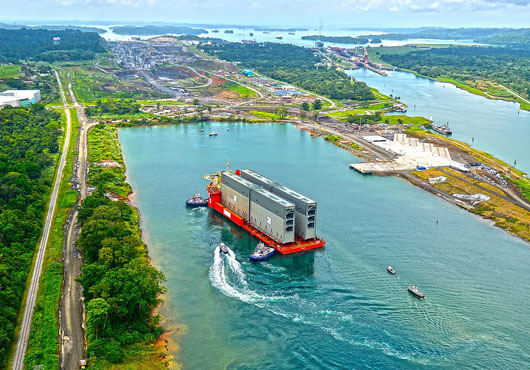Rivals in the world make Panama canal in stress

Despite having enjoyed a privileged position for many years, the canal is increasingly facing competition from other quarters. Because canal tolls have risen and as ships have become larger, some critics have suggested that the Suez Canal is now a viable alternative for cargo en route from Asia to the U.S. East Coast. The Panama Canal, however, continues to serve more than 144 of the world's trade routes and the majority of canal traffic comes from the "all-water route" from Asia to the U.S. East and Gulf Coasts via the Panama Canal.
On June 15, 2013, Nicaragua awarded the Hong Kong-based HKND Group a 50-year concession to develop a canal through the country.
The increasing rate of melting of ice in the Arctic Ocean has led to speculation that the Northwest Passage or Arctic Bridge may become viable for commercial shipping at some point in the future. This route would save 9,300 km (5,800 mi) on the route from Asia to Europe compared with the Panama Canal, possibly leading to a diversion of some traffic to that route. However, such a route is beset by unresolved territorial issues and would still hold significant problems owing to ice.
U.S. To Invest In A New Nicaragua Canal To Rival The Panama Canal
The U.S. public and private sectors would be willing to come together to jointly invest in the construction of a $40 billion “Nicaragua Canal” that would rival the Panama Canal, according to a U.S. Department of Commerce official.
Deputy Assistant Secretary Walter Bastian said that he finds the project “fascinating” and that the U.S. government will follow up to see if there is interest from U.S. investors.
Bastian said Tuesday while visiting Nicaragua that for the U.S. it is important that the process of awarding contracts is transparent and that those contracts have legal certainty.
Egypt plans Suez Canal expansion
Egypt plans to add an extra lane to the Suez Canal, one of the most important thoroughfares for world trade, in an attempt to increase the number of ships using it each day.
The Suez Canal, which allows ships to travel from Europe to Asia without passing southern Africa, currently only provides for one-way traffic, with occasional room for ships to pass each other. A planned new 72km lane, announced on Tuesday by Egypt’s president, Abdel Fatah al-Sisi, would allow ships to travel in both directions for just under half of the canal’s 162km length.
“This giant project will be the creation of a new Suez Canal parallel to the current channel,” said Mohab Mamish, the chairperson of the Suez Canal Authority, in a televised speech.
According to Egypt’s main state news website, Mamish hopes the new channel will be working within a year, but the likelihood of such a quick turnaround is by no means certain. It is also unclear to what extent the expansion would speed up the canal’s operations, said Angus Blair, a Cairo-based analyst who has followed the project’s development.
“They are only increasing capacity in a part of the canal, so the merits of it still have to be weighed up,” said Blair, the president of the Signet Institute, an economic and political think-tank. “They are essentially turning a motorway into a single-carriageway halfway through.”
Thailand to launch the Isthmus of Kra Canal
Growing calls are being heard regionally for the Thai government to speed up the reality of making the Kra Canal project happen. Pressure is growing for Thailand to step up work on the project, which stalled in recent years due to the country’s domestic political turmoil, is increasingly being seen as a means to boost to the economy as well as economies elsewhere in Asia.
The project – by far the largest development project ever undertaken in Asia – would build a Panama Canal-type short cut directly from the Indian Ocean to the South China Sea, something that would fundamentally change the face of the regions shipping.
Countries such as Singapore and Malaysia which have grown wealthy due to their location on the current route via the Straits of Malacca, are vehemently against the development of the Kra Canal as it would decimate their local port, shipping, logistics and related industries.
The prospect of cutting a channel through Thailand’s Kra Isthmus dates back several hundred years and was initially proposed in 1677 during the reign of Thailand’s King Narai the Great. The French began work on the canal but stopped shortly after, the British endorsed an engineering project, and the Japanese conducted feasibility studies. If realized, the Kra Canal would dwarf the Panama and Suez canals, would take at least ten years to construct, and is stated to be large enough to be visible from the moon.
The canal would generate an estimated annual trade turnover of some US$280 billion, and provide better access to about 1.2billion consumers that straddle the region within a radius of 2,400 kilometers. It would cut 1,000 kilometers off current shipping routes through the Straits of Malacca, saving about US$37,000 to US$120,000 to shipping companies per voyage in labor and fuel costs. Thailand would benefit enormously, as it would be projected immediately into a global hub for trading in commodities, currencies, financing, transshipment and similar services. A likely structure for the project may see the floating of a public company to raise funds, with the Thai government holding at least 51 percent, the public 29 percent and foreign investors a further 20 percent. The project needs less than 10 percent of the current Straits of Malacca shipping volume to break even.
HEADLINES
- Do shipping markets want Biden or Trump for the win?
- All 18 crew safe after fire on Japanese-owned tanker off Singapore
- Singapore launching $44m co-investment initiative for maritime tech start-ups
- Cosco debuts Global Shipping Industry Chain Cooperation Initiative
- US warns of more shipping sanctions
- China continues seaport consolidation as Dalian offer goes unconditional